Art Makeover – Revamp Your Old Paintings!

Let’s give an art makeover for an old painting! The idea for this blog post came last month when I was running out of paper. Instead of traveling to an art supply store, I stayed home as was advised, and found another solution: reusing old paintings!
My starting point was practical, but the benefits were spiritual – the journey that had ended, started again. I picked pieces that were made about 30 years ago – when I was in my 20s. At that time, I studied software engineering but still felt partly an artist.
Makeover Tip #1 – Change the Subject

The paintings from the 1990s look very different from my current work, but after examining old paint strokes, I did recognize myself. Although the strokes were rougher and the shapes simpler, they were still very much the same. The subject has changed, but my love for playing with shapes never went away.
Makeover Tip #2 – Save Something Old

When revamping the painting, I like to save something from the original one. So here, I kept a part of the yellow curtain but altered its color with a thin layer of paint so that it fits with the new color scheme. Old curtain, new home.
Makeover Tip #3 – Change the Colors
The old painting has screaming colors, but I wanted something more sophisticated for the revamped version, called “Ceruleana.” As the name suggests, the new painting is a tribute to Cerulean Blue.

Cerulean Blue is an expensive but lovely color, especially when mixed with white. It makes every engineer a romantic and looks heavenly with ochre and yellow tones.

But this post is not only about blues and its hues, I have another example too! This one has a lot of Magenta (“Medium Magenta” of Golden Acrylics), and the colors are very different from the original muddy version.
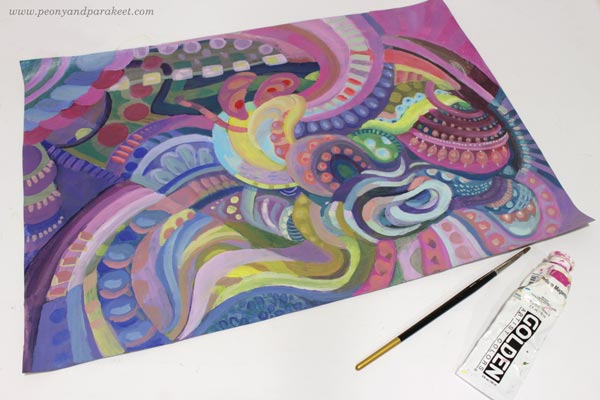
Art Makeover Tip #4 – Change the Orientation
The original was an artistic self-portrait like the first one. I did those a lot back then, and in every picture, I tried to look a bit different. But my imagination never got this far! The revamped version is horizontal but here they are side by side so that you can compare.

I like how the original version is still present in the new one!
Makeover Tip #5 – Use the Old Painting as a Foundation
This magenta abstract was so much fun to make. The old painting was like a map that had roads and towns, and when trusting them to lead me to one place to another, I didn’t have to worry about composition or such. I picked the easy abstract painting style from my class Planet Color. The whole process was relaxing, and the painting is called “Cosytopia.” A place to escape the big bad world.

Extreme Art Makeover – Polish and Varnish!
Like in any makeover, why not do it to the very end! Take care that the brushstrokes are smooth where they need to be, and shapes stylish enough for a party.
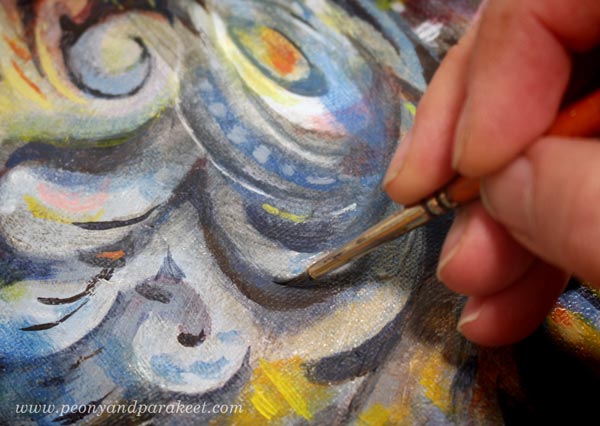
If the painting has a sturdy background, varnish it too! Ceruleana was painted on a cardboard canvas, so I used a polymer varnish on it. Before the varnish, I added a layer of glossy gel medium. (A detailed post about varnishing)
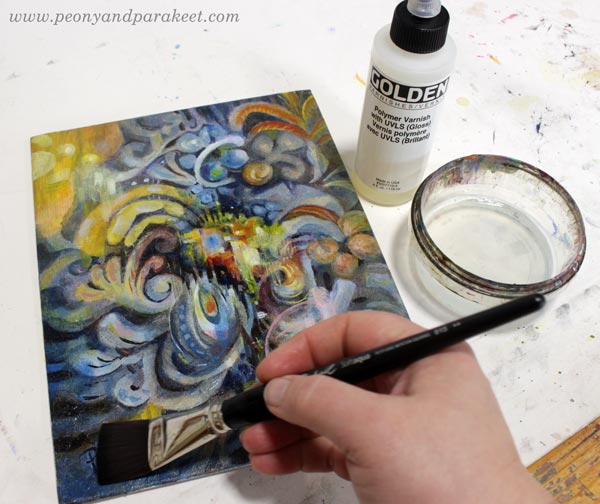
Glossy varnish makes colors glow beautifully. Even if this is an old revamped acrylic painting on cardboard, it may happen that someone someday says: “Oo-oh, it’s an oil painting, isn’t it?”

I hope this post inspired you to make the most of your supplies and past artistic endeavors!
Planet Color – Weekend Sale!

My beginner painting class Planet Color is for sale between May 28th to 31st! The normal price is 35 EUR, now only 25 EUR. >> Buy here!
Cobalt Blue Spectral and Experimenting with Watercolors

This week, I want to share something I don’t always do publicly: experimenting! The exploration and experimentation also have an important role in my upcoming class Magical Forest, so it’s a perfect time for some play!
Why Experiment?
Experiments are great, especially when:
– you want to try out new art supplies
– you are working on a bigger piece and need time to think between layers
– you have a very limited time to create
– you want to practice new techniques
– the process feels more important than the outcome: you need just to relax
This time, I could tick all the boxes! I had bought some new pans last week. A bigger painting was in progress. It was a late evening when I started painting. I wanted to use mostly angular, not so many organic shapes than usually, and I had lots of cheap watercolor paper for fun.
Cobalt Blue Spectral – Using Color as an Inspiration
I like to start an experiment by deciding a color or a couple of colors that I particularly enjoy. This time, I had a special treat – Cobalt Blue Spectral.

I have a small local art supply store in Helsinki, Finland, called Diverse. There are bigger stores in Helsinki too, but the service is never as good. The owner always has time to talk, and he knows what he sells. I happened to mention that I loved Cobalt Blue Spectral and that it’s so sad that St. Petersburg doesn’t produce it anymore. It was just one little sentence, among many. However, the sentence was heard, and I was astonished when the owner suddenly handed me a blue pan saying: “This is the last one that I have, and it’s from my personal collection.” So now, I have this amazing color again: Cobalt Blue Spectral. It’s much brighter than the usual cobalt and quite extraordinary indeed!

I also bought a few pans manufactured by Roman Szmal. The brand name is Aquarius, and I like all the Aquarius pans I have. Here I am testing a wonderful yellow Quinacridone Gold. I can’t get enough of warm yellows, and this is the most beautiful I have had so far. It’s golden orange when it’s thick, and lovely warm yellow when thinned.
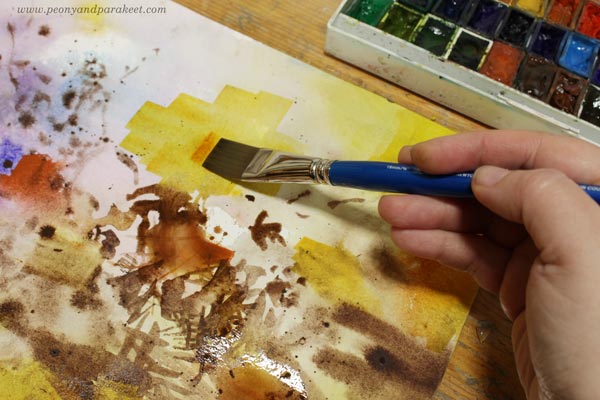
Multi-tasking
I like to paint many small studies at the same time so that when I wait one to dry, I can continue another one.

Looking for the Blank Spots
A big part of the play for me is to notice all the small little accidents, especially the blank spots, and figure out how to save and highlight them as the painting progresses.
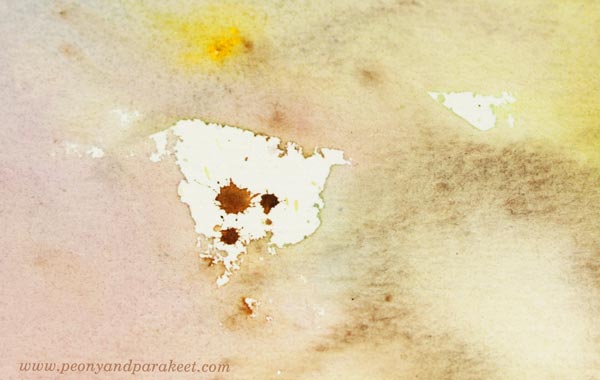
Including Experimentation for More Serious Pieces
I like to start bigger projects with an experimental mindset too. I use a lot of water so that I can later decide which accidents to enhance and which to hide. A spraying bottle is my trusted assistant.
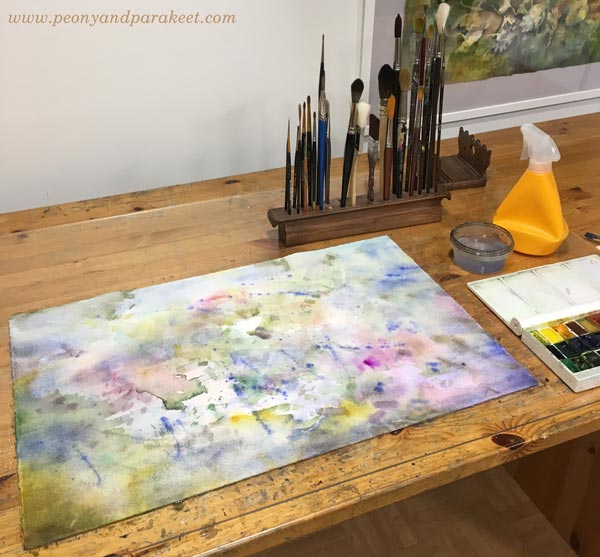
The size of this painting in progress is a half sheet (approximately 38 x 56 cm / 15 x 22 inches). It has 100 % cotton paper, and Cobalt Blue Spectral shows there too. Compared to the experiments, my painting pace is much slower.

My little art room has been a watercolor studio during the last weeks. I also bought a cheap interchangeable frame from Ikea and ordered a Passepartout from a local framer. Now I can easily display half-sheet paintings!
Magical Forest – Come to Paint and Experiment with me!
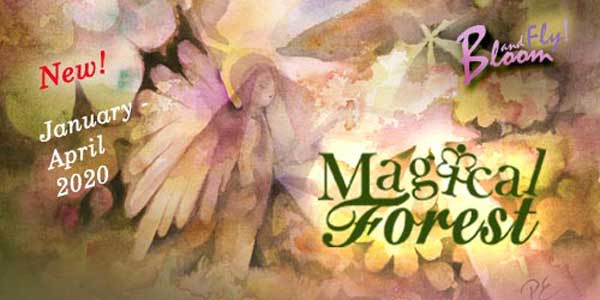
Start the new year with the new class Magical Forest!
The early-bird sale ends on Cyber Monday, Dec 2 midnight PST.
>> Sign up Now!
Painting Watercolor Still Lives

I usually have a lot to say but this time I can barely type any words. I am madly in love with painting watercolor still lives. They keep coming! It feels that any topic can be put in the form of
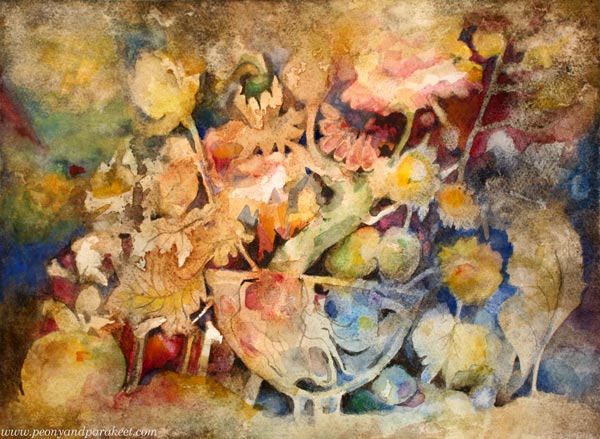
I think that art is this kind of a bonsai: even if it would be nourished very little, it keeps staying alive, producing flowers and fruit. It’s both ancient and fresh at the same time.
First a Mess, Then a Still Life!
I love how watercolors have a mind of their own. Especially, when painting without reference photos, the first brush strokes feel exciting and the possibilites seem endless.
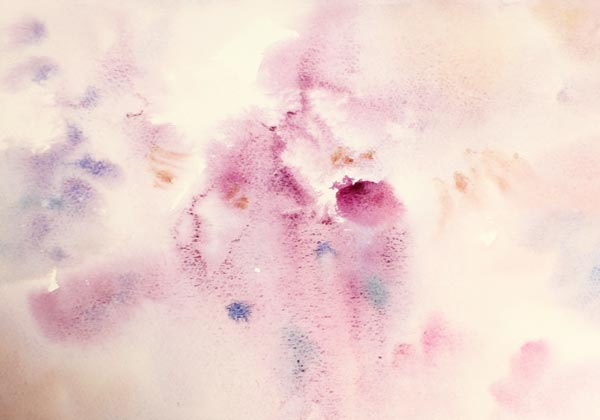
The bonsai painting was just a mess after the first layers. I had a lot of fun making the mess!
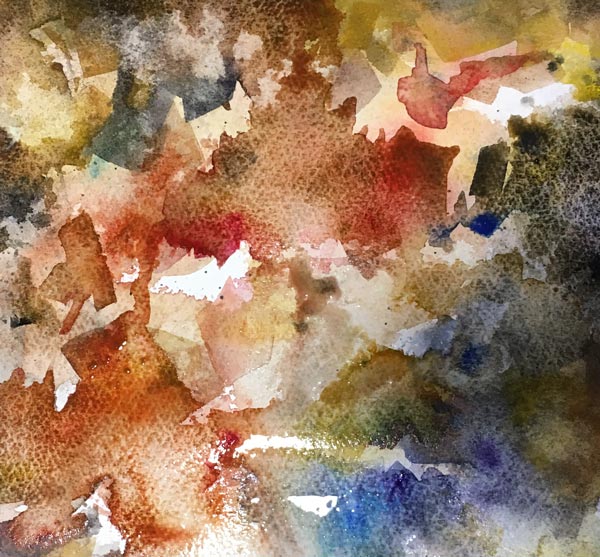
But I even had more fun bringing out the bonsai.

I use an abstract approach, and it’s so exciting that it keeps me painting. What was first just a clumsy geometric shape is soon a delicate flower! I teach this technique in the upcoming class Floral Fantasies.

My Watercolor Set – A Mix of Brands
I like to use pans more than tubes because it’s much quicker to start painting right away, not wasting time for opening and cleaning the caps. But I also buy tubes because when a pan gets empty, I can use a tube to refill it.

My watercolor set of 36 pans is originally White Nights by St. Petersburg, but within
New Pans – Roman Szmall Aquarius
One of my latest purchases are pans manufactured by Roman

Drawing a Watercolor Chart
Always when I change the pans, I also draw a new chart in a notebook. This is how the chart looks currently (VG = Van Gogh, RS = Roman Szmal, DS = Daniel Smith, “Oma

I love to curate my palette. When one color runs out, I consider carefully whether I buy more or change it! I also like to examine what the best order is for the pans, and as you see from the chart above, I often change the order a bit! This is my way to bond with the supplies, and every time I begin a new painting, I feel that they are my team, working with me!
Painting Watercolor Still Lives Together

Come to draw and paint flowers with me – Sign up for Floral Fantasies in 3 Styles!
Varnishing, Framing, and Celebrating Your Best Paintings

I have finished an oil painting called “Temptation.” I started it at the beginning of this year and after tens of painting sessions and weeks of drying time, I finally got it finished, varnished, and framed. So it’s time for celebration! So, the theme for this blog post is our best work, and especially our best paintings.
I have been planning this post for well over a year to get all the images I want to show you, and the experiences that I want to share with you, so I am happy that with the latest painting, the time has come for this article too!
Best Work – How to Know?
In art, there are very few absolute rights and wrongs, so this question can have many answers. But here’s how I know when I have produced my best work:
1) Time: I have worked on the painting for tens of hours and tens of sessions. Even if some artists work quickly, in general, most people underestimate the time that professional artists spend with their pieces. Overworking is rarer than underworking!
2) Message: I know why the painting exists. I can start a painting without a specific idea in mind, but when the painting progresses, I need to find a connection and a story to be able to make all the decisions needed.
3) Details: I have paid attention to every area of the painting. Some areas can be freer or less detailed than others but they have to be aligned with the overall message of the painting, supporting the most important areas.

Best Work – Test!
I have a couple of tests that I always use for my best work. Try these!
A) Do you want to hang your painting on your wall?
Here, I mean your painting, on your wall in your home. When I use this test, I don’t imagine anyone else’s home or anyone else’s wall. If I don’t want the painting on the wall, it’s likely that no one else will either.
B) Do you see your painting as a treasure?
Place the painting on the table, walk away from the room, and then come back and glance at it. If your instant reaction is that there’s a valuable item on the table, the painting is close to the finish. Here, the difficult thing is that you need to recognize your reaction quickly and glance at the painting from a distance. The further away you can be and get the impression of a treasure, the better. When I use this test, I try to alienate myself from the painting before entering the room.

When you have produced a painting that meets your criteria, why not varnish, frame and celebrate it?! These are all important steps to me. Let’s start with varnishing!
Before Varnishing – Take Photos!
Varnishing makes the painting harder to photograph because it will have glares more easily. If you have produced your best work, you will also want to get good photos of them! I use a tripod when taking photos, and if the weather is good, I take the photos in natural light.

Varnishing an Oil Painting – The Traditional Way
Oil paintings are tricky to varnish because they dry slowly. The drying time depends on how thick the layers are and how much drying time there has been between them. In any case, it’s months, and it can be more than a year! With “Gypsy Madonna,” I waited for nine looooong months. Every layer had dried a week or more, and they were very thin, so based on the advice that I got, that would be enough.
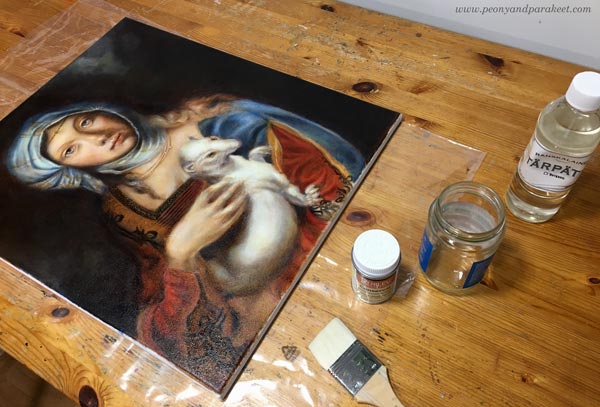
I bought Rublev Conservar Dammar Gloss Varnish with UV protection and applied it with a broad and soft goat bristle brush.
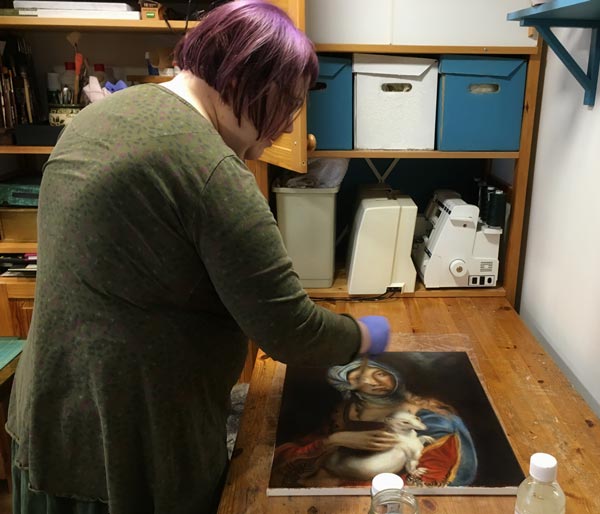
Always when varnishing, it’s good to:
1) double-check and follow the instructions of the specific product that you use. Don’t rely on the instructions that come with the bottle but go to the manufacturer’s website to see if there’s more advice.
2) apply a small amount of varnish and keep the layer thin.
3) let the previous varnishing layer dry properly before adding a new layer. Usually, a couple of layers are needed.
4) if possible, reserve a brush for varnishing only
Varnishing an Oil Painting – A Quick Solution
Luckily, there’s an alternative for traditional oil varnishes. It’s called Gamvar Picture Varnish. I got to know about it from my artist friend Eeva Nikunen. She has also made a process video about using Gamvar.

This medium only requires the surface to feel dry. So it can be applied after a few weeks after finishing the oil painting. I used Gamvar for the first time now, and because it’s thicker, it’s much easier to handle than the traditional varnish. Spreading Gamvar is more like rubbing with small strokes than painting with long strokes. A little sturdier brush works better here. I used a watercolor brush.

The pleasure of varnishing is the same regardless of the medium. The colors become more vibrant, and the painting begins to shine. I prefer using glossy to matte varnishes because I love the extra glow!
Varnishing an Acrylic Painting
Varnishing is not just for oil paintings! You can varnish acrylic paintings as well, just remember that they have their own products. I mostly use Golden acrylic paints, so when varnishing acrylic paintings, I have also used products of the same brand.
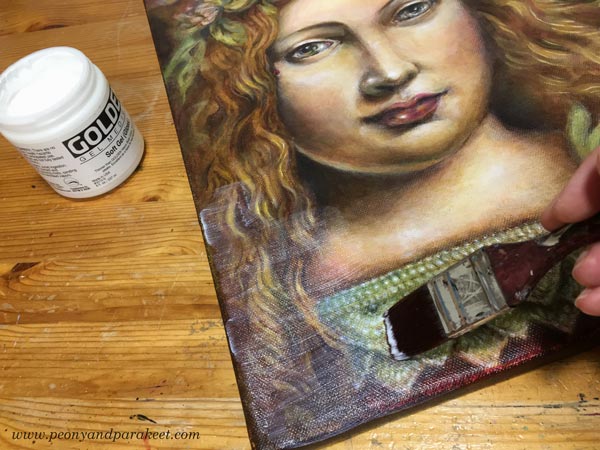
First, I add a layer or two of gel medium (Golden Soft Gel Gloss) before I begin the varnishing. Gel medium separates the paint layers from the varnishing layer. I mix some water with the gel medium to make it more fluid so that the brush strokes don’t show so well. I use a broad and flat brush and let every layer dry before adding a new one. It’s good to wait at least a day because polymer products can feel dry even if they haven’t dried properly yet.

Then I add 1-3 layers of Golden’s glossy polymer varnish. It has to be mixed with water, and every layer has to dry 3-6 hours before adding a new one. I try not to put too much pressure on the brush so that the brush strokes won’t show.
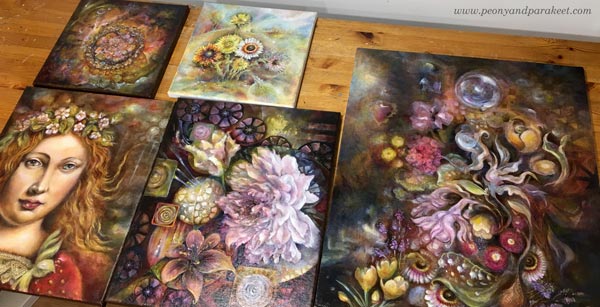
I think that after varnishing, the increase of the vibrancy is as visible as with oil paintings. Definitely worth the effort!
Celebrating the Finished Painting – Framing
If my opinion, the best way to celebrate the finished painting is to get it framed. If varnishing is the makeup, framing is the dress. The impact of the frame is incredible when it fits well and continues the personality of the painting. Sorry about the glare in the sample images!

I use a local professional framer because I love the quality. I chose an old-fashioned and heavy frame for the Renaissance-style painting, and it made it look like an old masterpiece. Without frames, the image was much more modest.
For this acrylic painting, I chose a dark frame that makes the colors shine.

If the frame were lighter, the dark colors of the background would have got more attention, and the result wouldn’t be as harmonic.
Today, I got “Temptation” from the framer. Because this painting is like a collection of treasures, I wanted the frame to be luxurious too.

Celebrating the Finished Painting – Music!
I also like to celebrate my best pieces by listening to some music when admiring them. I try to find a song that is aligned with the painting and it’s often a song that I have already listened when working on the piece. For “Temptation”, the song is Musetta’s aria from Puccini’s opera “La Boheme”. After exposing the painting to the critical eye for so long, it’s time to forget the struggles and enjoy the accomplishment. I find this combination of musical and visual pleasure one of the best joys in life.

I hope you too will celebrate your best work!
P.S. “Temptation” is now available in my art store, see more detailed photos there!